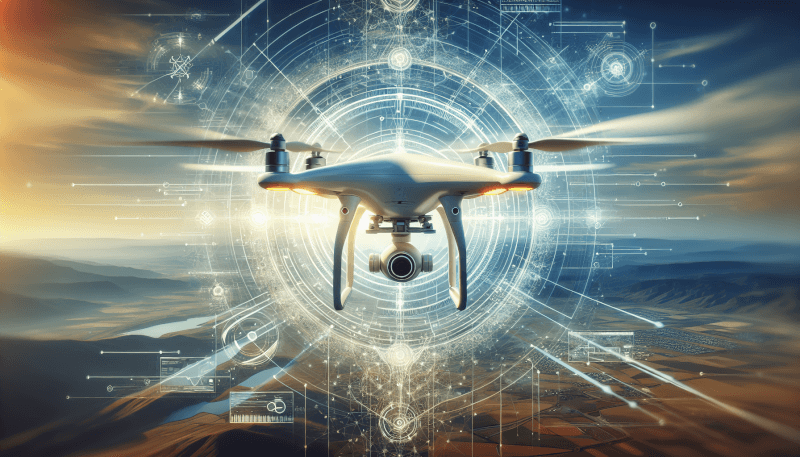Imagine you’re soaring high in the sky, looking down at the world below through the lens of a drone equipped with cutting-edge artificial intelligence technology. Picture the possibilities: from delivering packages with pinpoint accuracy to conducting efficient search and rescue missions. With the latest advancements in artificial intelligence for drones, these seemingly futuristic scenarios are becoming a reality. In this article, we’ll explore the incredible breakthroughs in AI that are revolutionizing the drone industry, paving the way for a future where machines and humans collaborate seamlessly in the sky. So fasten your seatbelt and get ready to discover the exciting world of AI-powered drones!

Autonomous Navigation
Autonomous navigation is one of the most significant advancements in the field of artificial intelligence for drones. With the introduction of collision avoidance systems and simultaneous localization and mapping (SLAM), drones are now capable of navigating complex environments on their own, without the need for constant human intervention.
Collision Avoidance Systems
Collision avoidance systems are designed to detect and avoid obstacles in the path of a drone. Using a combination of sensors, such as cameras and ultrasonic sensors, these systems are able to recognize objects and calculate their distance from the drone. By continuously monitoring the surroundings, collision avoidance systems can make real-time adjustments to the drone’s trajectory to prevent any potential collisions.
Simultaneous Localization and Mapping (SLAM)
Simultaneous localization and mapping (SLAM) is a technique that enables drones to create a map of their environment in real-time while also determining their own position within that map. By utilizing sensors, such as cameras or LIDAR, drones can capture visual or depth information of their surroundings. This data is then processed using SLAM algorithms to construct a 3D map and simultaneously locate the drone within that environment. SLAM technology allows drones to navigate autonomously in both indoor and outdoor settings, even in GPS-denied areas.
Object Detection and Recognition
Object detection and recognition play a crucial role in enabling drones to understand and interact with their environment. With the aid of deep learning algorithms and computer vision techniques, drones can accurately identify and classify objects in real-time, allowing for a wide range of applications.
Deep Learning Algorithms
Deep learning algorithms, such as convolutional neural networks (CNN), have revolutionized object detection and recognition in drones. These algorithms are trained on large datasets containing images with annotated objects, allowing the drone to learn and recognize various objects. By extracting features from the input images, deep learning algorithms can accurately detect objects and categorize them into different classes. This capability opens up possibilities for applications such as surveillance, wildlife monitoring, and even delivery services.
Computer Vision Techniques
Computer vision techniques complement deep learning algorithms in object detection and recognition for drones. By utilizing image processing and pattern recognition algorithms, drones can analyze visual data captured by cameras and make sense of the environment. These techniques enable drones to detect and track objects in real-time, providing valuable information for tasks such as monitoring crops in precision agriculture or identifying damaged infrastructure in inspection missions.
Real-Time Decision Making
Real-time decision making is an essential aspect of artificial intelligence for drones. By deploying reinforcement learning and adaptive control systems, drones can adapt to changing conditions and make intelligent decisions on the fly.
Reinforcement Learning
Reinforcement learning is a machine learning technique that enables drones to learn how to make optimal decisions based on their actions and the feedback they receive. By defining a reward system, drones can learn through trial and error, continuously refining their decision-making process. This allows them to adapt to different scenarios and optimize their actions in real-time. With reinforcement learning, drones can perform tasks such as search and rescue operations or navigate through challenging environments with greater efficiency.
Adaptive Control Systems
Adaptive control systems play a vital role in ensuring the stability and maneuverability of drones during autonomous flights. These systems continuously monitor the drone’s behavior and adjust the control inputs accordingly to maintain stability and respond to external disturbances. By adapting to changing conditions, drones can maintain precise control and complete missions with enhanced safety and efficiency.
Swarming and Coordination
Swarming and coordination involve the collaboration of multiple drones to achieve complex tasks. By utilizing distributed AI systems and collective intelligence algorithms, drones can work together seamlessly, enabling advanced capabilities that were once difficult to achieve with individual drones.
Distributed AI Systems
Distributed AI systems leverage the power of multiple drones working together as a networked entity. Each drone acts as an autonomous agent, capable of making decisions based on its own perception of the environment and sharing information with other drones in the network. By distributing tasks among the drones, the system can optimize efficiency and accomplish tasks that would typically require multiple drones working independently.
Collective Intelligence Algorithms
Collective intelligence algorithms facilitate the coordination and collaboration of drones in a swarm. These algorithms enable drones to communicate and cooperate, allowing them to achieve shared objectives. By sharing information about their positions, tasks, and observations, drones can make joint decisions, adapt to changing conditions, and accomplish tasks more effectively. Collective intelligence algorithms have promising applications in various fields, including surveillance, disaster response, and environmental monitoring.

Precision Agriculture
Artificial intelligence has tremendous potential in revolutionizing agriculture, and drones equipped with advanced AI capabilities are playing a significant role in precision agriculture.
Crop Health Monitoring
By utilizing AI-powered image analysis techniques, drones can monitor the health of crops more efficiently and accurately than ever before. Through the analysis of aerial imagery, drones can identify signs of diseases, nutrient deficiencies, or other abnormalities in plants. This information allows farmers to take timely actions, such as targeted pesticide application or precise nutrient supplementation, minimizing crop losses and optimizing yields.
Automated Irrigation Systems
Drones equipped with AI algorithms can also contribute to efficient water management in agriculture. By collecting and analyzing data on soil moisture levels, temperature, and plant health, drones can determine precise irrigation needs. With this information, automated irrigation systems can be controlled, reducing water waste, improving crop health, and optimizing water usage in agriculture.
Environmental Monitoring
Drones equipped with AI capabilities are proving to be valuable tools for environmental monitoring, enabling the collection of crucial data for various ecological studies and conservation efforts.
Wildfire Detection
Wildfire detection is a critical application of drones in environmental monitoring. Equipped with thermal cameras and AI algorithms, drones can quickly identify potential fire hotspots by analyzing temperature variations. This early detection enables rapid response, allowing firefighting teams to take immediate action and prevent the spread of wildfires more effectively.
Air and Water Quality Assessment
Drones can also play a role in assessing air and water quality. By collecting samples and analyzing the data, drones can provide valuable insights into pollution levels, allowing for targeted environmental remediation efforts. AI-powered algorithms can process the collected data in real-time, providing actionable information to aid in decision-making related to environmental conservation and remedial actions.

Infrastructure Inspection
Drones equipped with AI technology have become invaluable assets in infrastructure inspection, facilitating more efficient and accurate assessments of bridges, buildings, and power lines.
Bridge and Building Inspections
Drones offer a cost-effective and safer alternative to manual inspections of bridges and buildings. Equipped with high-resolution cameras and AI-powered image analysis algorithms, drones can capture detailed imagery of structures, flagging potential issues such as cracks, corrosion, or structural damage. By automating the inspection process, drones enable faster and more thorough assessments, reducing the risks associated with traditional inspection methods.
Power Line Monitoring
Drones equipped with AI algorithms are also enhancing the monitoring and maintenance of power lines. By conducting aerial inspections, drones can detect damaged or faulty equipment, identify vegetation encroachments, and assess the overall condition of power line infrastructure. This information allows utility companies to plan maintenance activities efficiently, preventing potential power outages and ensuring the reliability and safety of the power grid.
Delivery and Logistics
The use of drones in delivery and logistics has gained significant attention, and artificial intelligence is powering the advancements in this field.
Route Optimization
AI algorithms enable drones to optimize delivery routes by considering various factors such as distance, weather conditions, and traffic congestion. By analyzing real-time data and making intelligent decisions, drones can minimize delivery times and ensure efficient logistics operations. This capability has the potential to revolutionize last-mile delivery services, allowing for faster and more cost-effective delivery of goods.
Package Tracking Systems
AI-powered package tracking systems enable drones to accurately track and deliver packages to their intended destinations. By integrating computer vision algorithms and barcode recognition technologies, drones can scan and identify individual packages, ensuring accurate delivery. This level of automation and precision in package tracking helps streamline logistics operations and enhances the overall efficiency of delivery services.

Search and Rescue Operations
Artificial intelligence has the potential to greatly enhance search and rescue operations, allowing drones to efficiently locate and assist those in need.
Victim Detection
Drones equipped with thermal cameras and AI algorithms can detect and locate victims in challenging environments. By analyzing thermal signatures, drones can differentiate between humans and their surroundings, enabling swift detection and rescue operations. This capability is particularly valuable in situations such as natural disasters, where time is of the essence and access to remote or dangerous areas is limited.
Navigation in Challenging Environments
AI-enabled drones can navigate through challenging environments, including dense forests, rugged terrains, or areas with limited GPS coverage. By employing advanced sensor fusion techniques and AI algorithms, drones can autonomously adapt their flight paths to avoid obstacles and find alternative routes, ensuring effective search and rescue missions even in the most demanding scenarios.
Humanitarian Aid
Artificial intelligence-powered drones are also playing a crucial role in humanitarian aid, enabling faster response and efficient delivery of essential supplies in times of crisis.
Disaster Response
During natural disasters or humanitarian crises, drones equipped with AI capabilities can provide vital support to emergency responders. By conducting aerial assessments, delivering medical supplies, or assisting in search and rescue operations, drones can overcome logistical challenges and reach affected areas more quickly. The autonomous capabilities of AI-powered drones contribute to timely and effective disaster response efforts, helping save lives and alleviate suffering.
Medical Supply Delivery
Drones equipped with medical supply delivery systems are revolutionizing healthcare access, particularly in remote or underserved areas. By delivering essential medical supplies, such as vaccines, blood samples, or medications, drones can bridge the gap in healthcare delivery and ensure timely access to life-saving resources. The integration of AI algorithms in delivery systems enables the drones to optimize routes, track inventory, and adapt to changing conditions, ensuring reliable and efficient delivery of medical supplies.
In conclusion, the latest advancements in artificial intelligence for drones have opened up a wide range of possibilities across various domains. From autonomous navigation and object detection to real-time decision making and swarming capabilities, drones equipped with AI technology are transforming industries such as agriculture, environmental monitoring, infrastructure inspection, logistics, search and rescue, and humanitarian aid. With continued advancements and research in this field, the potential for using drones with AI capabilities to solve complex problems and improve efficiency is limitless.



